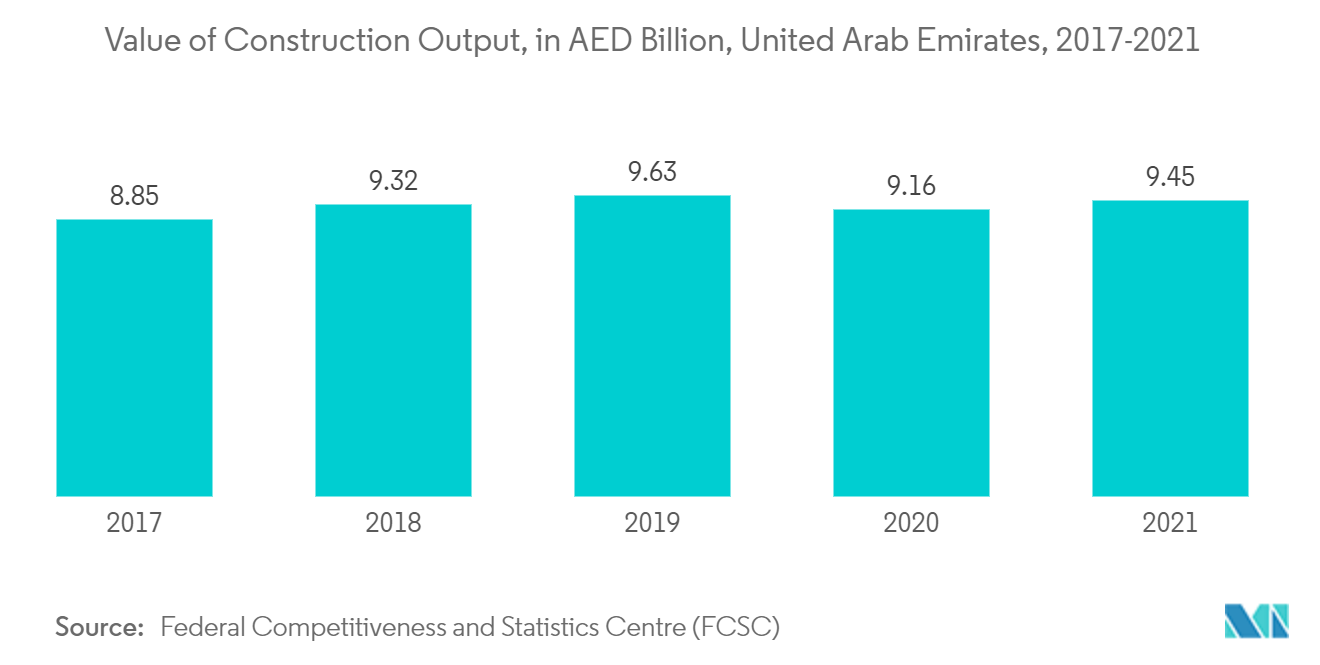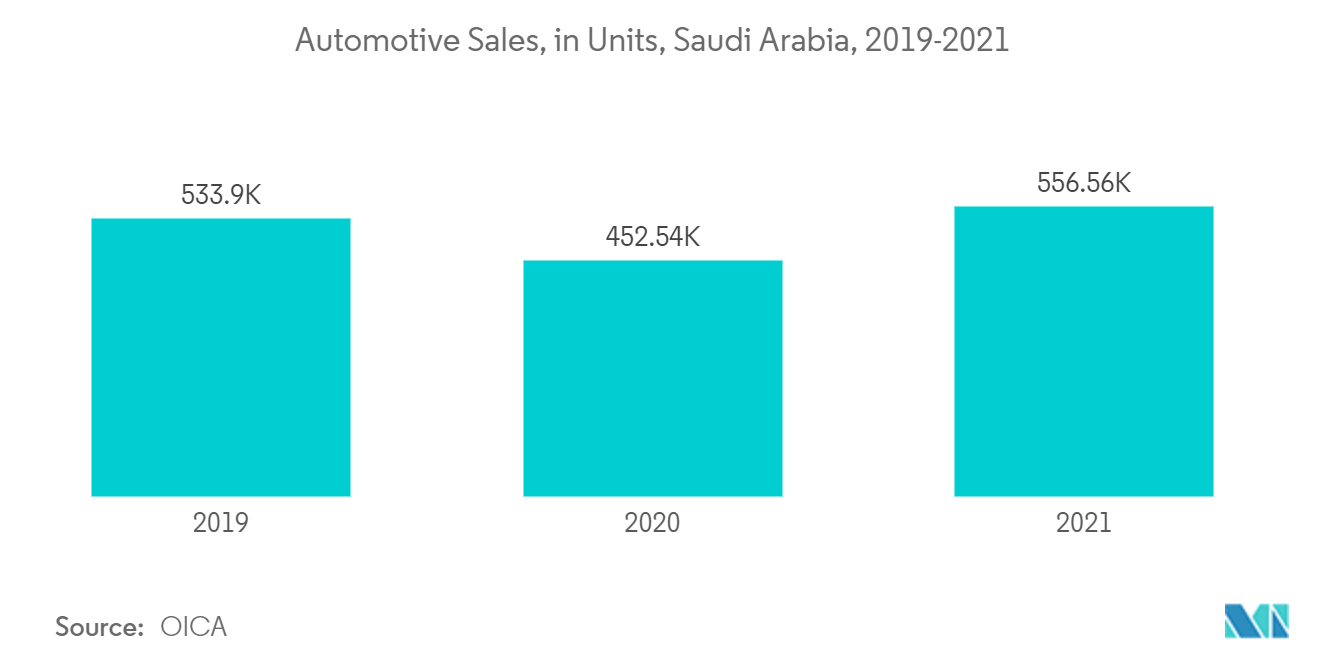Market Trends of Middle East Polyethylene Industry
This section covers the major market trends shaping the Middle East Polyethylene Market according to our research experts:
Increasing Demand in the Building and Construction Industry
- Polyethylene is used in building and construction for pipe-in-pipe, entryways, rooftop sheets, and slabs. The characteristics of polyethylene, such as strong thermal insulation, frost resistance, and flexibility, promote its usage in a variety of construction applications.
- Furthermore, polyethylene is employed in the building industry as window films, flooring, countertop protection, and even roofing. Polyethylene sheet is also used to seal rooms and cover construction components.
- The Middle Eastern construction industry is expanding. For economic diversification, the Saudi government is focusing on boosting the education, healthcare, infrastructure, and industrial sectors. As a result, demand for institutional, residential, industrial, and commercial buildings is likely to rise.
- From 2010 to 2025, Saudi Arabia's first-phase projects have a combined budget of USD 16.8 billion, including the construction and upgrade of 5500 kilometers. The Saudi Railway Master Plan's (SRMP) second-phase projects will build 3000 km of track for USD 55.7 billion, while the third-phase plans will build 1400 km of track for USD 24.8 billion between 2034 and 2040. It was also intended to gradually privatize services while independently maintaining the regulatory and operational sectors of the railway firm.
- Qatar pursued a wide range of infrastructural and industrial projects as part of its commitment to hosting the 2022 FIFA World Cup, its commitment to its National Vision 2030, and its objective of hosting the Asian Games in 2030. In the run-up to the 2022 FIFA World Cup, a few high-value road and rail transportation projects will be built over the following two years to improve connectivity and alleviate the problem of excessive congestion around Doha.
- The UAE is also working toward a brighter and more environmentally friendly future. Masdar Metropolis is the world's first zero-carbon, zero-waste, car-free city in Abu Dhabi. The United Arab Emirates effectively changed it from a future science notion to an organic, metropolitan organism. When completed in 2025, Masdar City will serve as a model for the rest of the region. The UAE construction industry is ready to enter a new period of growth, spurred by the country's lofty aspirations for the next 50 years and newer, more progressive legislation.
- According to Federal Competitiveness and Statistics Centre (FCSC), the value of construction output in the United Arab Emirates was AED 9.45 billion (USD 2.57 billion) as compared to AED 9.16 billion (USD 2.49 billion) in 2020.
- The Egyptian government is a significant player in the building business. A high-profile example is the Egyptian government's development of a massive "New Administrative Capital" 30 miles east of Cairo. The project's first phase, which includes all cabinet departments and authorities, is virtually complete, and the government will relocate to the new capital by the end of 2021.
- All the aforementioned factors are expected to drive construction activity in the Middle Eastern region, which also impacts the demand for polyethylene during the forecast period.

Saudi Arabia is Anticipated to Hold a Major Share in Middle East
- Saudi Arabia dominates the polyethylene market in terms of market share and market size. The country is likely to maintain its dominance over the forecast period.
- The Saudi economy is reliant on oil exports. Furthermore, the government has tight control over all key economic operations.
- The construction industry accounts for roughly 6%-7% of the country's total GDP. For economic diversification, the Saudi government is focusing on boosting the education, healthcare, infrastructure, and industrial sectors. As a result, demand for institutional, residential, industrial, and commercial buildings is likely to rise.
- The country is looking for qualified builders to shape its most ambitious projects, which have a USD 1.1 trillion project backlog. Saudi Arabia is amid Vision 2030, a major transformation agenda underpinned by megaprojects such as the Neom super-city tourist destination, the 334 km2 entertainment city of Qiddiya, the development at the UNESCO World Heritage site of Al-Ula, and the luxury and sustainable tourism-focused Red Sea Project.
- Furthermore, the Saudi Ministry of Housing stated announced its plan to build around 100,000 additional housing units in collaboration with real estate companies for a total cost of SAR 65 billion. Nineteen projects have already been announced in nine regions of the country, with an additional 40 private projects expected to offer 14,000 "villa" housing units in the country.
- Saudi Arabia is embarking on several residential and commercial projects, which are projected to boost the country's construction activity. The Neom Metropolis Project is a projected cross-border city in Tabuk Province, northwestern Saudi Arabia. Its goal is to have smart city technology while simultaneously serving as a tourism destination. The region is located in the northern Red Sea, south of Jordan and Israel, and east of Egypt across the Tiran Strait. It will cover an estimated 26,500 km2 and stretch 460 kilometers along the Red Sea coast.
- According to General Authority for Statistics (Saudi Arabia), the revenue from building construction in Saudi Arabia is expected to be roughly USD 28,7 billion by 2024. Polyethylene is employed in many transportation applications, such as glazing, interior wall panels, dividers, headliners, and light diffusers. According to the Central Department of Statistics and Information, the transportation sub-index of the Consumer Price Index (CPI) basket grew to 118.83 points in October 2022, up from 118.77 points in September 2022.
- According to the Organisation Internationale des Constructeurs d'Automobiles (OICA), automotive sales in Saudi Arabia accounted for 556,559 units in 2021, compared to 452,544 units in the previous year.
- Thus, all the above-mentioned factors are likely to provide growth opportunities for the Middle Eastern polyethylene market during the forecast period.

